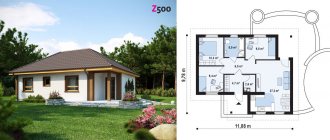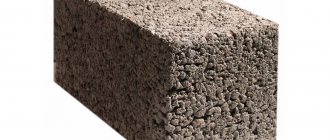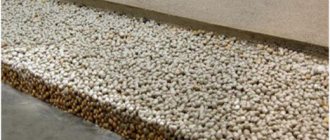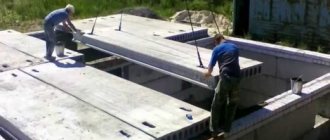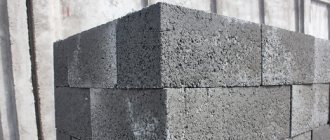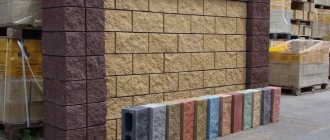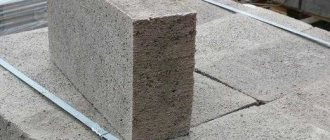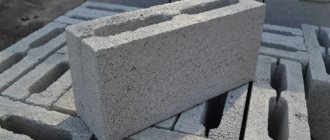- 1 Definition
- 2 Features
- 3 Where are they used?
- 4 Typical sizes and markings
- 5 Laying technology
- 6 Conclusion
All buildings and structures require high-quality ventilation in their designs; this can be done by using ventilation units. The use of expanded clay concrete ventilation blocks is intended to provide natural ventilation of buildings and does not require monitoring or adjustment. The production of such blocks occurs by casting in molds.
What is a ventilation expanded clay concrete block - rules of application
The ventilation system is a set of measures and devices that provide the calculated air exchange in the premises. Ventilation blocks made of expanded clay concrete are used in both brick and panel houses. The ventilation shaft is formed from individual modules, which are elements of the floor system. Porous blocks made of expanded clay concrete breathe, do not collect water in their structure and do not allow microorganisms to develop, with a high degree of fire resistance, which is very important in residential buildings. During construction there is no connection to the floor plan and crane; installation is carried out at any stage of the building’s construction.
Expanded clay concrete is characterized as a building material with high thermal insulation.
- What is a ventilation expanded clay concrete block?
- Material characteristics
- Application area
- Sizes and brands
- How to lay out ventilation blocks correctly?
Ceramic blocks and expanded clay concrete blocks for ceramic chimneys and ventilation
Ceramic chimney pipes installed outside and inside the building require protection from mechanical and temperature influences, and thermal insulation. For this, expanded clay concrete blocks are used for the chimney and ventilation. Most manufacturers producing ceramic smoke exhaust systems produce modules that come as standard or are purchased separately.
Types of blocks for chimneys
Chimney ceramic and expanded clay blocks are made from light grades of concrete and clay. The design of the modules depends on the type of smoke removal system. Manufacturers offer the following types of blocks:
- Single-pass - the module design consists of a frame, with one hole for the chimney pipe. Thermal insulation is placed between the ceramics of the pipe and the block.
Two-way - the module has two channels for pipes, separated by a partition. The blocks are used for two-pass ceramic chimneys designed to simultaneously remove combustion products and supply air to the combustion chamber.
- With ventilation - blocks for ventilation ducts and chimneys have one feature that distinguishes them from one- and two-pass structures. The systems have one or more ventilation ducts.
What and how are chimney blocks made of?
Today, there are three main methods for producing chimney blocks, each of them differs in strength and thermal insulation characteristics:
Chimney made of expanded clay concrete blocks - lightweight grades of concrete are used in production. Manufacturing takes place using an autoclave. After pouring, a vibration machine is used to maximize compaction of the composition and avoid voids. Expanded clay concrete blocks are used in industrial and private systems for removing combustion products, and have a long service life.
Ceramic chimney blocks are produced by firing fireclay clay. Designed for domestic use. When purchasing ceramic blocks, it is better to refuse modules whose walls have cracks, which indicates violations during the production process. Ceramics has a porous structure and good thermal insulation properties, creates a natural vapor barrier, helping to maintain a balance of humidity outside and inside the structure, which reduces the amount of condensation produced.
Scope of application of ceramic blocks
Over the past 20-30 years, hollow ceramic blocks have become widely used for chimney laying.
Advantages of this type of structure: Good thermal insulation characteristics
Strength with a coefficient of at least M 100.
Ceramic blocks are used mainly in private construction. For connecting both individual and collective smoke removal systems.
Technical characteristics of ventilation units
Like expanded clay concrete wall blocks, ventilation elements comply with GOST 6133-99. They are made from a mixture of M400-M500 cement with expanded clay and a binding liquid by vibrocompression. The average density of products is 700-750 kg/cub.m. There are two-chamber and single-chamber elements. For external purposes, products with frost resistance of 50-100 cycles are used; The frost resistance of blocks for internal partitions is not regulated.
The wall thickness is 30 mm, which makes the block resistant to mechanical stress. Strength grade M75-M200.
The cross-section of through holes must be at least 200 sq.cm, for example, in a two-chamber product 400x200x200 mm, the size of the chambers is 130x150 mm.
In order to lay masonry in a foam block wall, the height of which exceeds standard expanded clay concrete products, “Eurostandard” ventilation elements 360x280x240 mm (2-chamber) and 310x310x240 mm (1-chamber) have been developed.
ThermoComfort expanded clay concrete blocks for ventilation ducts 400x300x240 per piece
Description
Dimensions, mm: 360*280*240 Structure: hollow (2 voids), ventilation On pallet: 0.876 cubic meters, 36 pcs, Pallet weight, kg: 550
| block density, kg/m 3 | 600 ± 10% |
| characteristic compressive strength, N/mm 2 | not less than 2.5 |
| fire resistance, class | A1 (non-flammable) |
| fire resistance limit REI, min | REI 150 |
| frost resistance, number of cycles | 50 |
| comparative coefficient of vapor permeability μ (GOST EN 1745-2015) | 5/15 |
| specific effective activity of natural radionuclides, Bq/kg, with a norm of no more than 370 | 195 (material corresponds to class I) |
The blocks are shipped from a warehouse in Misnka and can be carried out to the customer’s transport or delivered to the construction site by a vehicle with a hydraulic manipulator. The cost of delivery is calculated separately based on the transportation route, the characteristics of access roads, as well as the required placement of blocks at the construction site (on the foundation, basement, 1st, 2nd floor, etc.). Expanded clay concrete blocks "ThermoComfort" of this standard size are shipped individually.
Expanded clay concrete blocks “ThermoComfort”, produced by JSC Expanded Clay Gravel Plant Novolukoml, are today one of the best wall masonry materials presented on the market of the Republic of Belarus.
Compared to gas silicate blocks, expanded clay concrete blocks "ThermoComfort" have a number of significant advantages. Firstly, from the point of view of environmental friendliness, expanded clay concrete blocks are significantly superior to gas silicate blocks. Expanded clay gravel is a natural, environmentally friendly material that is baked foamed clay. Due to its structure and physical properties, it is used to insulate floors, walls and ceilings of buildings. It is thanks to the expanded clay gravel that is part of the expanded clay concrete blocks that ThermoComfort blocks have increased heat capacity and very low thermal conductivity.
The structure of expanded clay concrete blocks “ThermoComfort” is characterized by the presence of voids “slots”, and therefore they are called “slit type” blocks. The cracks create additional air spaces in the walls, which have a significant positive effect on the thermal conductivity of the walls. Walls made of expanded clay concrete blocks "ThermoComfort" are much warmer than walls made of gas silicate blocks. In comparison with expanded clay concrete blocks from other manufacturers, blocks produced by JSC Expanded Clay Gravel Plant Novolukoml have an increased number of rows of slots, in the 400 - 13 rows, in the 300 - 9 rows, in the 200 - 5 rows.
Expanded clay concrete blocks of the TermoComfort slotted type also have a tongue-and-groove structure, which avoids the presence of vertical joints when laying walls. Those. each block is connected to the neighboring one in special grooves, due to which unnecessary cold bridges disappear in places where the adhesive or cement-sand composition is located.
The concrete included in the expanded clay concrete blocks "ThermoComfort" provides high strength of the material, due to which the expanded clay concrete blocks "ThermoComfort" are used in the construction of multi-story buildings in private and commercial construction.
Where are they used?
The use of ventilation expanded clay concrete is relevant for:
- chimney;
- fence posts;
- for ventilation of public buildings;
- ventilation ducts;
- sanitary facilities and kitchens;
- permanent formwork.
As an example, expanded clay concrete chimneys, which have the following advantages:
- ease and speed of chimney installation;
- reduction of loads on the base of the chimney;
- the presence of an additional unit for a large amount of ventilation;
- The chimney can be installed in the walls, which allows you to save the area of the room.
Expanded clay blocks use a process of sintering the solution under high pressure. This technology provides chimney blocks with strength characteristics and a long service life.
Where are they used?
Chimney made of expanded clay concrete. The use of ventilation expanded clay concrete is relevant for:
- chimney;
- fence posts;
- for ventilation of public buildings;
- ventilation ducts;
- sanitary facilities and kitchens;
- permanent formwork.
As an example, expanded clay concrete chimneys, which have the following advantages:
- ease and speed of chimney installation;
- reduction of loads on the base of the chimney;
- the presence of an additional unit for a large amount of ventilation;
- The chimney can be installed in the walls, which allows you to save the area of the room.
Expanded clay blocks use a process of sintering the solution under high pressure. This technology provides chimney blocks with strength characteristics and a long service life.
Return to contents
Projects of houses made of expanded clay concrete blocks
- 6 rooms
- 2 bathrooms
- 203² Total area
- 12 x 14m Construction area
- 6 rooms
- 3 bathrooms
- 247² Total area
- 16 x 10m Construction area
- 4 rooms
- 2 bathrooms
- 150² Total area
- 5 rooms
- 2 bathrooms
- 166² Total area
- 12 x 12m Construction area
- 6 rooms
- 3 bathrooms
- 298² Total area
- 16 x 13m Construction area
- 5 rooms
- 3 bathrooms
- 192² Total area
- 13 x 13m Construction area
- 6 rooms
- 2 bathrooms
- 159² Total area
- 12 x 11m Construction area
- 5 rooms
- 2 bathrooms
- 170² Total area
- 10 x 11m Construction area
Laying technology
The installation of ventilation units begins with the calculation of the features of buildings and structures. To do this, it is worth inviting a professional architect. The action plan will reduce material costs and ensure the efficiency of the ventilation system. The technology for laying ventilation blocks is as follows:
- Work begins with preparing the workplace; to do this, remove debris that can create distortions and increase the strength of the connection of two different materials.
- After that, the work surface is moistened and covered with plugs, which will protect the ventilation channels from the solution.
- Next, take water, one part cement and three parts sand and make a solution. For more correct proportions and high-quality material, use a mixture made at the factory.
- After thoroughly mixing the components of the mixture, it is applied to the template.
- Stretch the cement composition along the cross-section using a trowel.
- After the rigger has inspected the block and given permission to lift it, it is loaded into the lifting mechanism.
- The ventilation unit at the installation site is controlled by installers to ensure that the holes correspond to the lower sections.
- To ensure the evenness of the structure, control its vertical position and, if necessary, adjust the position of the product.
- The embedded structural elements are secured to the walls using welding. It is important to maintain an even fixation of the block to prevent it from moving.
- At the end of laying the ventilation blocks, the seams are processed and sealed using a trowel.
Laying technology
Installation diagram of ventilation units. The installation of ventilation units begins with the calculation of the features of buildings and structures. To do this, it is worth inviting a professional architect. The action plan will reduce material costs and ensure the efficiency of the ventilation system. The technology for laying ventilation blocks is as follows:
- Work begins with preparing the workplace; to do this, remove debris that can create distortions and increase the strength of the connection of two different materials.
- After that, the work surface is moistened and covered with plugs, which will protect the ventilation channels from the solution.
- Next, take water, one part cement and three parts sand and make a solution. For more correct proportions and high-quality material, use a mixture made at the factory.
- After thoroughly mixing the components of the mixture, it is applied to the template.
- Stretch the cement composition along the cross-section using a trowel.
- After the rigger has inspected the block and given permission to lift it, it is loaded into the lifting mechanism.
- The ventilation unit at the installation site is controlled by installers to ensure that the holes correspond to the lower sections.
- To ensure the evenness of the structure, control its vertical position and, if necessary, adjust the position of the product.
- The embedded structural elements are secured to the walls using welding. It is important to maintain an even fixation of the block to prevent it from moving.
- At the end of laying the ventilation blocks, the seams are processed and sealed using a trowel.
Return to contents
Peculiarities
Ventilation expanded clay concrete blocks are of the following types:
Prefabricated. Such a ventilation structure, connecting two elements, is assembled by welding, which facilitates the transportation and construction of these materials and reduces costs. Of the minuses, there is a low reliability indicator due to possible joint seams.- Monolithic blocks for ventilation consist of a prefabricated and satellite duct, as well as 2 additional elements. The advantage of a monolithic product is to ensure complete sealing of the structure, strength and efficiency.
Advantages of expanded clay concrete blocks for ventilation:
- the use of such blocks can provide natural ventilation of buildings and structures without the use of air ducts and other technical devices;
- are able to form a separate natural ventilation system, without the need for control and adjustment.
Disadvantages of expanded clay concrete ventilation block:
- the need for preliminary calculations when drawing up plans for buildings and structures, which entails the expenditure of funds to attract a specialist;
- ability to provide simple ventilation;
- do not replace air cooling devices.
Return to contents
What is a ventilation expanded clay concrete block?
According to the type of structure, the structure is rectangular in shape, made of expanded clay and can have from 1 to 4 openings intended for conducting utilities and natural ventilation systems in buildings and structures. The composition of the stone includes: purified sand, cement and expanded clay (up to 80%) - a light porous building material obtained by firing fusible clay, in the production of which no artificial impurities are used.
Material characteristics
The technical characteristics of the blocks are specified in GOST 6133–99. Expanded clay concrete blocks have a number of properties, such as high frost resistance, water resistance, thermal insulation and sound insulation parameters, which are among the main criteria for housing comfort. More details about the characteristics of the building material are presented in the table:
Typical sizes and markings
Expanded clay products are marked depending on the following parameters:
- type;
- type of material;
- resistance of concrete to aggressive environments;
- size;
- seismic resistance;
- standard designations for product manufacturing.
Thus, products are marked with the following letters: seismic resistance - C; type of concrete, only light - L; normal resistance - N, reduced - P, especially low - O. The length and height of the products are marked with the corresponding numbers. The following sizes of expanded clay ventilation elements are distinguished by brand:
- BV-28 has a length, width, and height of 278 centimeters, 80 centimeters, 40 centimeters, respectively;
- BV-29 – 283 cm, 80 cm, 40 cm;
- BV-30 – 298 cm, 80 cm, 0 cm;
- BV-31 – 131 cm, 80 cm, 40 cm;
- BV-33 - 328 centimeters, 80 centimeters, 40 centimeters.
There are also other grades of concrete with their corresponding sizes.
Return to contents
Block manufacturing technology
The technology for making blocks from expanded clay concrete is quite simple. The material is prepared on the basis of a mixture of expanded clay or expanded clay sand with cement. Since the cost of the initial components and energy resources spent during production is not high, expanded clay concrete blocks are not expensive. Expanded clay concrete is characterized as a building material with high thermal insulation. Excellent insulating properties are achieved during its manufacture. In the production of expanded clay concrete blocks, the so-called technology of plugged holes is used, as a result of which even the concrete solution does not penetrate into the material during masonry, while the air bubbles remaining in the pores of the block provide high insulating qualities. This technology for manufacturing expanded clay concrete blocks makes it possible to achieve a high degree of sound insulation and moisture resistance. You can build bathhouses from expanded clay concrete blocks and not be afraid that mold or mildew will appear in the walls. In addition, during the production of expanded clay concrete, small polystyrene balls are added to the molds, which, by reducing the density of the product, increase the frost resistance of the material.
Ventilation blocks
A ventilation system is a combination of distribution devices to ensure the necessary air exchange in a building. One of these modules are ventilation blocks made of expanded clay concrete.
Sometimes ceramics are used as ventilation pipes. Due to the fragility of the material, these products require protection from mechanical stress. And for such purposes, expanded clay concrete products are used, produced by manufacturers complete with pipes.
Square ventilation units
What are ventilation products?
A ventilation unit is a device made of expanded clay concrete, which is used in the construction industry of residential buildings. The use of expanded clay blocks is the best option implemented in channel designs.
With the help of these devices, simple and optimal ventilation is organized in bathrooms, kitchens and toilets.
Product characteristics
Expanded clay, a product in the form of granules, is a lightweight material and has long been used as a filler in the manufacture of blocks.
It is a mixture of fired clay, concrete and liquid. In cross-section, this is the structure of frozen foam, protected by a shell, which, in turn, gives the substance greater strength. Expanded clay is resistant to rotting and burning.
The physical qualities and dimensions of expanded clay blocks directly affect the division of modules by type. The strength of the blocks depends on the material from which they are made.
Today there are three types of ventilation modules:
- Concreted;
- Reinforced concrete;
- Expanded clay concrete.
Each product category has its own manufacturing technology, but we will consider in more detail only the method of producing expanded clay concrete blocks.
It differs from the first two types of products in that the composition of concrete with expanded clay is used in its manufacture. A block of expanded clay concrete in its properties is between a brick and a foam block.
The first product conveys its strength and resistance to low temperatures. And from the concrete foam device it inherited low weight with large dimensions and low thermal conductivity.
In this regard, ventilation blocks made of this material are universal. They can be used both for direct application in the form of wells and for the protection of ceramic or asbestos cement pipes.
Ready-made ventilation modules
Product parameters
The technical conditions stipulate certain dimensions of expanded clay concrete devices, depending on the application. They come in heights equal to one floor.
Average prices for materials
The cost is determined by the brand of cement used in production, the type of expanded clay and the type of block. The most popular product is considered to be M75 , which has sufficient technical indicators for building houses.
| Material type | Amount in a package | Price per piece/rub. | Price per m 3 /rub. |
| 2-hollow | 90 | 35 | 2100 |
| 3-hollow | 90 | 47 | 2800 |
| 4-hollow | 90 | 40 | 2500 |
| 7 slot | 90 | 43 | 2700 |
| 11 slot | 60 | 69 | 4300 |
| 18 slot | 72 | 56 | 3700 |
| septal | 120-156 | 27-36 | 3400-4300 |
| inter-apartment | 72 | 65 | 3200 |
vote
Article rating

